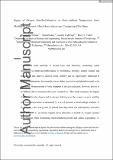Impact of Oxygen Non‐Stoichiometry on Near‐Ambient Temperature Ionic Mobility in Polaronic Mixed‐Ionic‐Electronic Conducting Thin Films
Author(s)
Defferriere, Thomas; Kalaev, Dmitri; Rupp, Jennifer L. M.; Tuller, Harry L.
Download10.1002-adfm.202005640.pdf (1.802Mb)
Open Access Policy
Open Access Policy
Creative Commons Attribution-Noncommercial-Share Alike
Terms of use
Metadata
Show full item recordAbstract
Enhanced ionic mobility in mixed ionic and electronic conducting solids contributes to improved performance of memristive memory, energy storage and conversion, and catalytic devices. Ionic mobility can be significantly depressed at reduced temperatures, for example, due to defect association and therefore needs to be monitored. Measurements of ionic transport in mixed conductors, however, proves to be difficult due to dominant electronic conductivity. This study examines the impact of different levels of quenched-in oxygen deficiency on the oxygen vacancy mobility near room temperature. A praseodymium doped ceria (Pr0.1Ce0.9O2–δ ) film is grown by pulsed laser deposition and annealed in various oxygen partial pressures to modify its oxygen vacancy concentration. Changes in film non-stoichiometry are monitored by tracking the optical absorption related to the oxidation state of Pr ions. A 13-fold increase in ionic mobility at 60 °C for increases in oxygen non-stoichiometry from 0.032 to 0.042 is detected with negligible changes in migration enthalpy and large changes in pre-factor. Several factors potentially contributing to the large pre-factor changes are examined and discussed. Insights into how ionic defect concentration can markedly impact ionic mobility should help in elucidating the origins of variations seen in nanoionic devices.
Date issued
2021-01-22Department
Massachusetts Institute of Technology. Department of Materials Science and Engineering; Massachusetts Institute of Technology. Department of Electrical Engineering and Computer ScienceJournal
Advanced Functional Materials
Publisher
Wiley
Citation
Defferriere, T., Kalaev, D., Rupp, J. L. M., Tuller, H. L., Impact of Oxygen Non-Stoichiometry on Near-Ambient Temperature Ionic Mobility in Polaronic Mixed-Ionic-Electronic Conducting Thin Films. Adv. Funct. Mater. 2021, 31, 2005640
Version: Author's final manuscript
ISSN
1616-301X
1616-3028